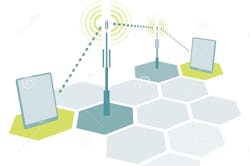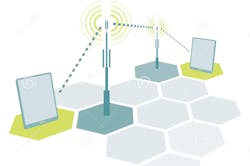Most of you are intimately familiar with the popular short-range wireless technologies such as Wi-Fi, Bluetooth, ZigBee, 802.15.4, and maybe even Z-Wave. All of these are addressing the Internet-of-Things (IoT) movement. But there are other, lesser-known technologies worth considering. I have identified three that justify a closer look, especially if longer range is a requirement: These are LoRa, Sigfox, and Weightless.
All of these are relatively new and solve the range problem for some IoT or Machine-to-Machine (M2M) applications. These technologies operate in the <1 GHz unlicensed spectrum. Lower frequencies always give longer range for a given power level,Up until now, cellular connections have been used to implement M2M or IoT monitoring and control applications with a range greater than several hundred meters. Most cellular operators offer an M2M service, and multiple cell phone module makers can provide the hardware. But because of the technical complexity and high cost, cellular is not the best solution for a simple monitoring or control application.
These newer technologies offer the range needed at lower cost and significantly lower power consumption. This new category is known now as low power wide area networks (LPWANs). These are beginning to emerge as a significant competitor to cellular in the IoT/M2M space. Recent investigation by Beecham Research predicts that by 2020 as much as 26% of IoT/M2M coverage will be by LPWAN.
LoRa
LoRa stands for long-range radio. This technology is a product of Semtech. Typical operating frequencies are 915 MHz for the U.S., 868 MHz for Europe, and 433 MHz for Asia. The LoRa physical layer (PHY) uses a unique form of FM chirp spread spectrum, along with forward error correction (FEC), allowing it to demodulate signals 20 to 30 dB below the noise level. This gives it a huge link budget with a 20- to 30-dB advantage over a typical FSK system.
The spread spectrum modulation permits multiple radios to use the same band if each radio uses a different chirp and data rate. Data rates range from 0.03kb/s to 37.5 kb/s. Transmitter power level is 20 dBm. Typical range is 2 to 5 km, and up to 15 km is possible depending upon the location and antenna characteristics.
The media-access-control (MAC) layer is called LoRaWAN. It is IPv6 compatible. The basic topology is a star where multiple end points communicate with a single gateway, which provides the backhaul to the Internet. Maximum payload in a packet is 256 bytes. A CRC is used for error detection. Several levels of security (EUI64 and EUI128) are used to provide security. Low power consumption is a key feature.
Sigfox
Sigfox is a French company offering its wireless technology, as well as a local LPWAN for longer-range IoT or M2M applications. It operates in the 902-MHz ISM band but consumes very little bandwidth or power. Sigfox radios use a controversial technique called ultranarrowband (UNB) modulation. UNB is a variation of BPSK and supposedly produces no sidebands if zero or negative group delay filters are use in implementation. It uses only low data rates to transmit short messages occasionally. For example, Sigfox has a maximum payload separate from the node address of 12 b. A node can send no more than 140 messages per day. This makes Sigfox ideal for simple applications such as energy metering, alarms, or other basic sensor applications. Sigfox can set up a local LPWAN, then charge a low rate for a service subscription.
Weightless
Weightless is an open-LPWAN standard and technology for IoT and M2M applications. It is sponsored by the Weightless SIG and is available in several versions. The original version, Weightless-W, was designed to use the TV white spaces or unused TV channels from 54 to 698 MHz. Channels are 6-MHz wide in the U.S. and 8-MHz wide in Europe. These channels are ideal to support long range and non-line of sight transmission. The standard employs cognitive radio technology to ensure no interference to local TV signals. The basestation queries a database to see what channels are available locally for data transmission. Modulation can be simple differential BPSK up to 16 QAM with frequency hopping spread spectrum supporting data rates from about 1 kb/s to 16 Mb/s. Duplexing is time-division (TDD). Typical maximum range is about 5 to 10 km.
Weightless-N is a simpler version using DBPSK for very narrow bands to support lower data rates. Weightless-P is a newer, more robust version using either GMSK or offset-QPSK modulation. Data rates can be up to 100 kb/s using 12.5 kHz channels. Both the N and P versions work in the standard <1GHz ISM bands. All versions incorporate encryption and authentication for security.
Other LPWAN Options
The three technologies listed above will probably dominate LPWAN applications, but there are a few other choices. One is a variation of Wi-Fi designated by the IEEE as standard 802.11af. It was designed to operate in the TV white spaces with 6 or 8 MHz channels. The modulation is OFDM using BPSK, QPSK, 16QAM, 64QAM or 256QAM. The maximum data rate per 6-MHz channel is about 24 Mb/s. Up to four channels can be bonded to get higher rates. Data base query is part of the protocol to identify useable local channels.
A forthcoming variation is 802.11ah, a non-white space <1GHz ISM bands version, addresses the Wi-Fi power consumption issue for simpler low speed applications. It is expected to be available in 2016.
Another IEEE standard identified for possible LPWAN is 802.22. This is another OFDM standard that has been around for years. Since 802.11af /ah and 802.22 use OFDM, their power consumption make them less desirable for low power applications. Their main advantage may be the higher data rates possible.
About the Author
Lou Frenzel
Technical Contributing Editor
Lou Frenzel is the Communications Technology Editor for Electronic Design Magazine where he writes articles, columns, blogs, technology reports, and online material on the wireless, communications and networking sectors. Lou has been with the magazine since 2005 and is also editor for Mobile Dev & Design online magazine.
Formerly, Lou was professor and department head at Austin Community College where he taught electronics for 5 years and occasionally teaches an Adjunct Professor. Lou has 25+ years experience in the electronics industry. He held VP positions at Heathkit and McGraw Hill. He holds a bachelor’s degree from the University of Houston and a master’s degree from the University of Maryland. He is author of 20 books on computer and electronic subjects.
Lou Frenzel was born in Galveston, Texas and currently lives with his wife Joan in Austin, Texas. He is a long-time amateur radio operator (W5LEF).

